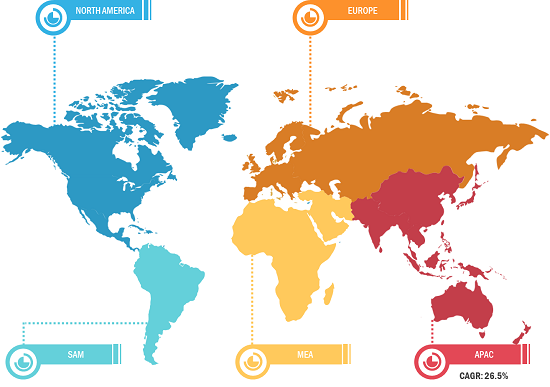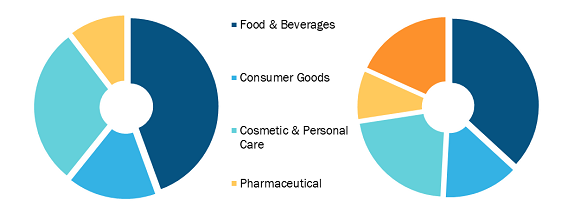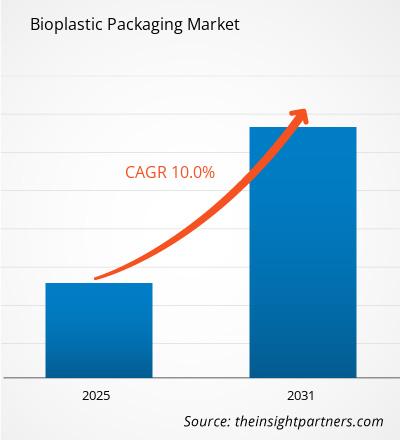Si prevede che il mercato degli imballaggi in bioplastica raggiungerà i 47.991,9 milioni di dollari entro il 2031 rispetto al dollaro 13.273,9 milioni nel 2022. Si prevede che crescerà a un CAGR del 23,9% tra il 2022 e il 2031.
Cibo & bevande, beni di consumo, cosmetici e prodotti di consumo. l'igiene personale e il settore farmaceutico sono tra i principali utilizzatori finali degli imballaggi in bioplastica. Gli imballaggi in plastica sono ampiamente utilizzati in varie applicazioni come beni di largo consumo, alimenti e prodotti alimentari. bevande, prodotti farmaceutici e beni di consumo. Questo maggiore utilizzo della plastica in diverse applicazioni è responsabile dell’aumento dell’inquinamento da plastica. Pertanto, il riciclaggio e il riutilizzo della plastica stanno diventando importanti per l’innovazione e la sostenibilità. Inoltre, si prevede che in futuro la plastica convenzionale diventerà più costosa a causa della diminuzione delle fonti di materie prime. Negli ultimi anni, la bioplastica ha influenzato l’industria della plastica attraverso l’innovazione per una maggiore efficienza delle risorse, funzionalità e sostenibilità. La bioplastica sta svolgendo un ruolo significativo nell’aumento degli obiettivi di riciclaggio e nel miglioramento della gestione dei rifiuti sostituendo le risorse petrolifere con risorse rinnovabili. Le bioplastiche sono prodotte utilizzando risorse vegetali rinnovabili, che offrono bassa tossicità, migliore riciclabilità e alta biodegradabilità.
Nel 2021, l'Europa deteneva una quota significativa del mercato degli imballaggi in bioplastica. Molte aziende manifatturiere su piccola e grande scala sono presenti nella regione. La crescente preferenza dei consumatori per i polimeri organici e naturali negli imballaggi alimentari sta influenzando positivamente il tasso di adozione di queste soluzioni di imballaggio sostenibili nei settori alimentare e industriale. settore delle bevande nella regione. Oltre alla consapevolezza dei consumatori, l'aumento delle iniziative governative che incoraggiano l'uso di prodotti di imballaggio ecologici in diversi paesi sta rafforzando la crescita del mercato.
Approfondimenti strategici
Impatto della pandemia di COVID-19 sul mercato degli imballaggi in bioplastica
Cibo & bevande, beni di consumo, cosmetici e prodotti di consumo. l’industria farmaceutica e quella dei prodotti per la cura della persona erano tra i principali generatori di domanda nel mercato degli imballaggi in bioplastica prima dell’inizio della pandemia di COVID-19. Tuttavia, il mercato ha dovuto affrontare ostacoli durante il primo trimestre del 2021 a causa della chiusura delle attività, della carenza di materie prime e dell’indisponibilità di manodopera. La pandemia di COVID-19 ha portato a una recessione economica nei primi mesi del 2021, che ha creato un onere finanziario per produttori e consumatori. Tuttavia, l’allentamento delle restrizioni sociali e l’aumento delle iniziative governative per rilanciare le loro economie hanno incoraggiato le industrie a iniziare a lavorare a pieno regime. Ciò alla fine ha contribuito al rilancio del mercato degli imballaggi in bioplastica alla fine del 2021.
Ripartizione del mercato degli imballaggi in bioplastica – per regione, 2021 < /h3>
< /h3>Approfondimenti di mercato
Aumentare la consapevolezza tra i clienti sugli effetti negativi delle plastiche convenzionali
Attualmente la bioplastica è un'alternativa a quasi tutti i materiali plastici convenzionali in diverse applicazioni. Le bioplastiche offrono soluzioni innovative con proprietà migliorate insieme alla capacità distintiva di ridurre le emissioni e fornire le stesse qualità e funzionalità della plastica convenzionale. Questi materiali di imballaggio biodegradabili sono realizzati utilizzando risorse rinnovabili e materie prime fossili come esteri di cellulosa, PLA (acido polilattico), PHA (poliidrossialcanoati), derivati dell'amido e copoliesteri come PBS (poli butilene succinato) e PBAT (poli butilene adipato). Co-tereftalato). Molti operatori del settore sono propensi a fornire soluzioni di imballaggio biodegradabili, a causa della crescente consapevolezza dei consumatori sull'impatto delle scelte di consumo sul loro stile di vita e sull'ambiente e della crescente domanda dei consumatori per prodotti più sostenibili. Il maggiore utilizzo di materiali di imballaggio in bioplastica sta contribuendo alla sostenibilità e riducendo l’impatto ambientale associato all’uso di polimeri convenzionali. Pertanto, il cambiamento nella domanda dei consumatori basato sulla consapevolezza ambientale, sullo stile di vita degli imballaggi, sulla praticità e sui sistemi di produzione sostenibili sta stimolando la crescita del mercato globale degli imballaggi in bioplastica.
Approfondimenti sulla categoria< /span>
In base al prodotto, il mercato degli imballaggi in bioplastica è segmentato in miscele di amido, acido polilattico, polietilene tereftalato, poliidrossialcanoati e polietilene. Nel 2021, il segmento delle miscele di amido ha rappresentato la quota maggiore di ricavi.
Mercato degli imballaggi in bioplastica, per applicazione: 2021 e 2031

NatureWorks LLC, Arkema, Novamont SpA, BASF SE, Braskem, Corbion NV, Cardia Bioplastic Packaging, Evonik Industries AG, Koninklijke DSM NV e Dow Chemical Company sono tra i principali attori che operano nel mercato. Queste aziende hanno ampi portafogli di prodotti per soddisfare la loro clientela proveniente da diversi paesi sviluppati e in via di sviluppo. Si concentrano inoltre sullo sviluppo di prodotti innovativi e di alta qualità per soddisfare le esigenze dei clienti.
Segnala Spotlights
- Tendenze progressive del settore nel mercato per aiutare i giocatori a sviluppare strategie efficaci a lungo termine
- Strategie di crescita aziendale adottate dalle aziende per garantire la crescita nei mercati sviluppati e in via di sviluppo
- Analisi quantitativa della dimensione del mercato degli imballaggi in bioplastica dal 2021 al 2031
- Stima della domanda globale di imballaggi in bioplastica
- Analisi PEST per illustrare l'efficacia di acquirenti e fornitori che operano nel settore
- Recenti sviluppi per comprendere lo scenario del mercato competitivo
- Tendenze e prospettive del mercato e fattori che guidano e frenano la crescita del mercato degli imballaggi in bioplastica
- Assistenza nel processo decisionale evidenziando le strategie di mercato che sostengono l'interesse commerciale
- La dimensione del mercato degli imballaggi in bioplastica nei vari nodi
- Panoramica dettagliata e segmentazione del mercato e dinamiche del settore degli imballaggi in bioplastica
- Dimensioni del mercato degli imballaggi in bioplastica in varie regioni con promettenti opportunità di crescita
L'"Analisi del mercato degli imballaggi in bioplastica fino al 2031" è uno studio specializzato e approfondito dell'industria chimica con particolare attenzione all'analisi delle tendenze. Il rapporto mira a fornire una panoramica del mercato con informazioni dettagliate sul mercato Segmentazione.Il mercato globale è stato analizzato sulla base del prodotto, del tipo, dell'applicazione e della geografia.In base al prodotto, il mercato è segmentato in miscele di amido, acido polilattico, polietilene tereftalato, poliidrossialcanoati e polietilene.In termini di tipo, il Il mercato globale è segmentato in imballaggi rigidi e imballaggi flessibili. In base all'applicazione, il mercato è segmentato in alimenti e bevande, beni di consumo, cosmetici e cura personale e prodotti farmaceutici. In base alla geografia, il mercato degli imballaggi in bioplastica è ampiamente segmentato nel Nord America, Europa, Asia Pacifico (APAC), Medio Oriente e Africa (MEA) e America meridionale e centrale.
Profili aziendali
- NatureWorks LLC
- Arkema
- Novamont SpA
- BASF SE
- Braskem
- Corbion NV
- Cardia Bioplastic Packaging
- Evonik Industries AG
- Koninklijke DSM NV
- Dow Chemical Company
- Analisi storica (2 anni), anno base, previsione (7 anni) con CAGR
- Analisi PEST e SWOT
- Valore/volume delle dimensioni del mercato - Globale, regionale, nazionale
- Industria e panorama competitivo
- Set di dati Excel



Report Coverage
Revenue forecast, Company Analysis, Industry landscape, Growth factors, and Trends

Segment Covered
This text is related
to segments covered.

Regional Scope
North America, Europe, Asia Pacific, Middle East & Africa, South & Central America

Country Scope
This text is related
to country scope.
Domande frequenti
Based on geography, Europe held the largest share of the bioplastic packaging market due to strong regulatory support for sustainable practices, a well-established infrastructure for bioplastics, and increasing consumer demand for eco-friendly packaging solutions.
Based on material, the bio-polylactic acid segment is expected to witness the fastest growth during the forecast period
The Bioplastic Packaging Market is estimated to witness a CAGR of 10% from 2023 to 2031
Stringent regulations on single-use plastics is driving the market growth.
Arkema SA; Avantium NV; BASF SE; Braskem SA; Eastman Chemical Company; Futamura Group; NatureWorks LLC; Neovia SAS; Novamont SpA; and Plantic Technologies Limited are some of the key players operating in the bioplastic packaging market
The increasing use of agricultural waste and by-products as raw materials is expected to be the key market trends.
Trends and growth analysis reports related to Chemicals and Materials : READ MORE..
The List of Companies
- NatureWorks LLC
- Arkema
- Novamont S.p.A.
- BASF SE
- Braskem
- Corbion N.V.
- Cardia Bioplastic Packaging
- Evonik Industries AG
- Koninklijke DSM N.V.
- Dow Chemical Company
The Insight Partners performs research in 4 major stages: Data Collection & Secondary Research, Primary Research, Data Analysis and Data Triangulation & Final Review.
- Data Collection and Secondary Research:
As a market research and consulting firm operating from a decade, we have published and advised several client across the globe. First step for any study will start with an assessment of currently available data and insights from existing reports. Further, historical and current market information is collected from Investor Presentations, Annual Reports, SEC Filings, etc., and other information related to company’s performance and market positioning are gathered from Paid Databases (Factiva, Hoovers, and Reuters) and various other publications available in public domain.
Several associations trade associates, technical forums, institutes, societies and organization are accessed to gain technical as well as market related insights through their publications such as research papers, blogs and press releases related to the studies are referred to get cues about the market. Further, white papers, journals, magazines, and other news articles published in last 3 years are scrutinized and analyzed to understand the current market trends.
- Primary Research:
The primarily interview analysis comprise of data obtained from industry participants interview and answers to survey questions gathered by in-house primary team.
For primary research, interviews are conducted with industry experts/CEOs/Marketing Managers/VPs/Subject Matter Experts from both demand and supply side to get a 360-degree view of the market. The primary team conducts several interviews based on the complexity of the markets to understand the various market trends and dynamics which makes research more credible and precise.
A typical research interview fulfils the following functions:
- Provides first-hand information on the market size, market trends, growth trends, competitive landscape, and outlook
- Validates and strengthens in-house secondary research findings
- Develops the analysis team’s expertise and market understanding
Primary research involves email interactions and telephone interviews for each market, category, segment, and sub-segment across geographies. The participants who typically take part in such a process include, but are not limited to:
- Industry participants: VPs, business development managers, market intelligence managers and national sales managers
- Outside experts: Valuation experts, research analysts and key opinion leaders specializing in the electronics and semiconductor industry.
Below is the breakup of our primary respondents by company, designation, and region:

Once we receive the confirmation from primary research sources or primary respondents, we finalize the base year market estimation and forecast the data as per the macroeconomic and microeconomic factors assessed during data collection.
- Data Analysis:
Once data is validated through both secondary as well as primary respondents, we finalize the market estimations by hypothesis formulation and factor analysis at regional and country level.
- Macro-Economic Factor Analysis:
We analyse macroeconomic indicators such the gross domestic product (GDP), increase in the demand for goods and services across industries, technological advancement, regional economic growth, governmental policies, the influence of COVID-19, PEST analysis, and other aspects. This analysis aids in setting benchmarks for various nations/regions and approximating market splits. Additionally, the general trend of the aforementioned components aid in determining the market's development possibilities.
- Country Level Data:
Various factors that are especially aligned to the country are taken into account to determine the market size for a certain area and country, including the presence of vendors, such as headquarters and offices, the country's GDP, demand patterns, and industry growth. To comprehend the market dynamics for the nation, a number of growth variables, inhibitors, application areas, and current market trends are researched. The aforementioned elements aid in determining the country's overall market's growth potential.
- Company Profile:
The “Table of Contents” is formulated by listing and analyzing more than 25 - 30 companies operating in the market ecosystem across geographies. However, we profile only 10 companies as a standard practice in our syndicate reports. These 10 companies comprise leading, emerging, and regional players. Nonetheless, our analysis is not restricted to the 10 listed companies, we also analyze other companies present in the market to develop a holistic view and understand the prevailing trends. The “Company Profiles” section in the report covers key facts, business description, products & services, financial information, SWOT analysis, and key developments. The financial information presented is extracted from the annual reports and official documents of the publicly listed companies. Upon collecting the information for the sections of respective companies, we verify them via various primary sources and then compile the data in respective company profiles. The company level information helps us in deriving the base number as well as in forecasting the market size.
- Developing Base Number:
Aggregation of sales statistics (2020-2022) and macro-economic factor, and other secondary and primary research insights are utilized to arrive at base number and related market shares for 2022. The data gaps are identified in this step and relevant market data is analyzed, collected from paid primary interviews or databases. On finalizing the base year market size, forecasts are developed on the basis of macro-economic, industry and market growth factors and company level analysis.
- Data Triangulation and Final Review:
The market findings and base year market size calculations are validated from supply as well as demand side. Demand side validations are based on macro-economic factor analysis and benchmarks for respective regions and countries. In case of supply side validations, revenues of major companies are estimated (in case not available) based on industry benchmark, approximate number of employees, product portfolio, and primary interviews revenues are gathered. Further revenue from target product/service segment is assessed to avoid overshooting of market statistics. In case of heavy deviations between supply and demand side values, all thes steps are repeated to achieve synchronization.
We follow an iterative model, wherein we share our research findings with Subject Matter Experts (SME’s) and Key Opinion Leaders (KOLs) until consensus view of the market is not formulated – this model negates any drastic deviation in the opinions of experts. Only validated and universally acceptable research findings are quoted in our reports.
We have important check points that we use to validate our research findings – which we call – data triangulation, where we validate the information, we generate from secondary sources with primary interviews and then we re-validate with our internal data bases and Subject matter experts. This comprehensive model enables us to deliver high quality, reliable data in shortest possible time.

 Ottieni un campione gratuito per questo repot
Ottieni un campione gratuito per questo repot